动词的时态和语态(1)
动词的时态和语态

一
二
三
四
五
六
七
八
九
十
十一
十二
十三
动词的时态和语态 -16-
3.一般过去时与过去进行时 尽管二者所表示的动作都发生在过去,但一般过去时着重强调过去的 动作,表示已经结束。而过去进行时仅表示过去某一点时间上,一个动作正 在进行,有什么样的结果不得而知。 He wrote three letters last night.(表示他写了三封信,暗指都已写完。) He was writing a letter at 9:00 last night.(表示当时他在写信,后来是否 写完就未知了。)
一
二
三
四
五
六
七
八
九
十
十一
十二
十三
动词的时态和语态 -10-
考点六 过去进行时
表示在过去某个时刻正在进行的动作,或者过去某个阶段正在做的事 情。 He was reading an interesting book this time yesterday.
一
二
三
四
五
六
七
八
九
十
十一
十二
十三
动词的时态和语态 -11-
一
二
三
四
五
六
七
八
九
十
十一
十二
十三
动词的时态和语态 -14-
考点十 几组时态的区别
1.一般过去时与现在完成时 时间上有差异:凡有过去时间的均用过去时态,不能用完成时态,如含有 ago,last year,just now,the other day 等。 结果上有差异:现在完成时强调的是对“现在”的影响和结果,动作到现 在刚完成或还在继续;一般过去时强调的是动作发生在“过去”,和现在毫无 关系。 I came to Beijing last year,and have been here since then.
英语语法:动 词 的 时 态 和 语 态
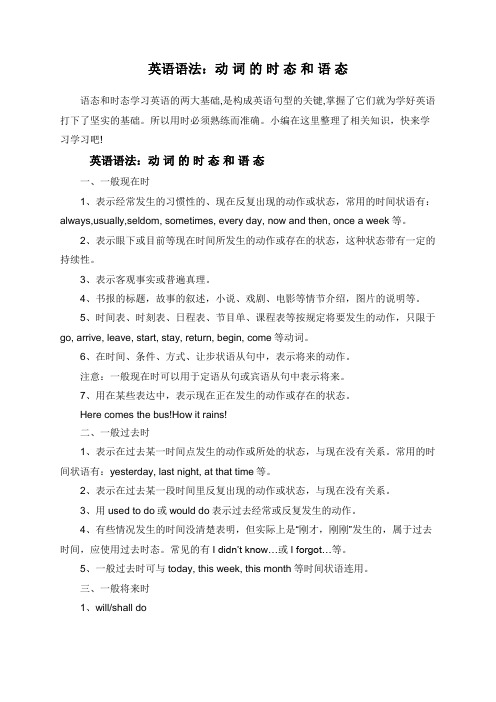
英语语法:动词的时态和语态语态和时态学习英语的两大基础,是构成英语句型的关键,掌握了它们就为学好英语打下了坚实的基础。
所以用时必须熟练而准确。
小编在这里整理了相关知识,快来学习学习吧!英语语法:动词的时态和语态一、一般现在时1、表示经常发生的习惯性的、现在反复出现的动作或状态,常用的时间状语有:always,usually,seldom, sometimes, every day, now and then, once a week等。
2、表示眼下或目前等现在时间所发生的动作或存在的状态,这种状态带有一定的持续性。
3、表示客观事实或普遍真理。
4、书报的标题,故事的叙述,小说、戏剧、电影等情节介绍,图片的说明等。
5、时间表、时刻表、日程表、节目单、课程表等按规定将要发生的动作,只限于go, arrive, leave, start, stay, return, begin, come等动词。
6、在时间、条件、方式、让步状语从句中,表示将来的动作。
注意:一般现在时可以用于定语从句或宾语从句中表示将来。
7、用在某些表达中,表示现在正在发生的动作或存在的状态。
Here comes the bus!How it rains!二、一般过去时1、表示在过去某一时间点发生的动作或所处的状态,与现在没有关系。
常用的时间状语有:yesterday, last night, at that time等。
2、表示在过去某一段时间里反复出现的动作或状态,与现在没有关系。
3、用used to do或would do表示过去经常或反复发生的动作。
4、有些情况发生的时间没清楚表明,但实际上是“刚才,刚刚”发生的,属于过去时间,应使用过去时态。
常见的有I didn’t know…或I forgot…等。
5、一般过去时可与today, this week, this month等时间状语连用。
三、一般将来时1、will/shall do(1)表示将来会出现的动作或状态。
什么是动词的时态和语态
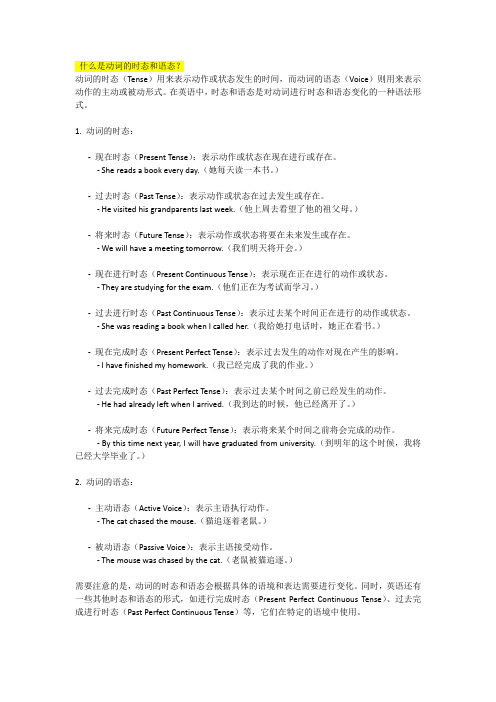
什么是动词的时态和语态?动词的时态(Tense)用来表示动作或状态发生的时间,而动词的语态(Voice)则用来表示动作的主动或被动形式。
在英语中,时态和语态是对动词进行时态和语态变化的一种语法形式。
1. 动词的时态:-现在时态(Present Tense):表示动作或状态在现在进行或存在。
- She reads a book every day.(她每天读一本书。
)-过去时态(Past Tense):表示动作或状态在过去发生或存在。
- He visited his grandparents last week.(他上周去看望了他的祖父母。
)-将来时态(Future Tense):表示动作或状态将要在未来发生或存在。
- We will have a meeting tomorrow.(我们明天将开会。
)-现在进行时态(Present Continuous Tense):表示现在正在进行的动作或状态。
- They are studying for the exam.(他们正在为考试而学习。
)-过去进行时态(Past Continuous Tense):表示过去某个时间正在进行的动作或状态。
- She was reading a book when I called her.(我给她打电话时,她正在看书。
)-现在完成时态(Present Perfect Tense):表示过去发生的动作对现在产生的影响。
- I have finished my homework.(我已经完成了我的作业。
)-过去完成时态(Past Perfect Tense):表示过去某个时间之前已经发生的动作。
- He had already left when I arrived.(我到达的时候,他已经离开了。
)-将来完成时态(Future Perfect Tense):表示将来某个时间之前将会完成的动作。
- By this time next year, I will have graduated from university.(到明年的这个时候,我将已经大学毕业了。
英语动词时态和语态
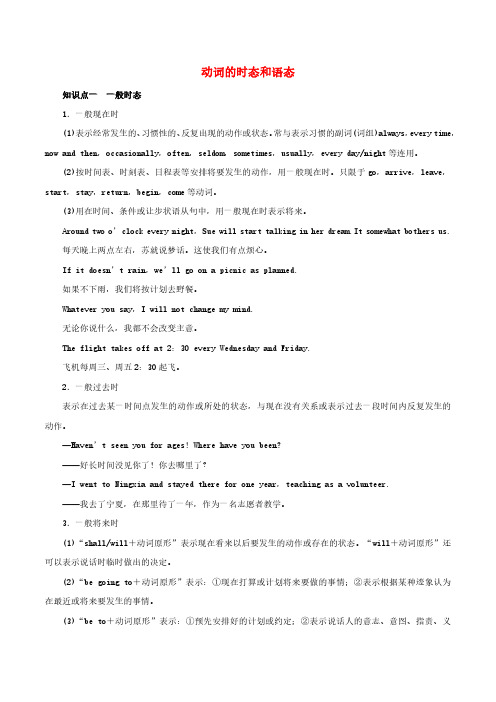
动词的时态和语态知识点一一般时态1.一般现在时(1)表示经常发生的、习惯性的、反复出现的动作或状态。
常与表示习惯的副词(词组)always,every time,now and then,occasionally,often,seldom,sometimes,usually,every day/night等连用。
(2)按时间表、时刻表、日程表等安排将要发生的动作,用一般现在时。
只限于go,arrive,leave,start,stay,return,begin,come等动词。
(3)用在时间、条件或让步状语从句中,用一般现在时表示将来。
Around two o’clock every night,Sue will start talking in her dream.It somewhat bothers us.每天晚上两点左右,苏就说梦话。
这使我们有点烦心。
If it doesn’t rain,we’ll go on a picnic as planned.如果不下雨,我们将按计划去野餐。
Whatever you say,I will not change my mind.无论你说什么,我都不会改变主意。
The flight takes off at2:30every Wednesday and Friday.飞机每周三、周五2:30起飞。
2.一般过去时表示在过去某一时间点发生的动作或所处的状态,与现在没有关系或表示过去一段时间内反复发生的动作。
—Haven’t seen you for ages!Where have you been?——好长时间没见你了!你去哪里了?—I went to Ningxia and stayed there for one year,teaching as a volunteer.——我去了宁夏,在那里待了一年,作为一名志愿者教学。
3.一般将来时(1)“shall/will+动词原形”表示现在看来以后要发生的动作或存在的状态。
动词的时态和语态
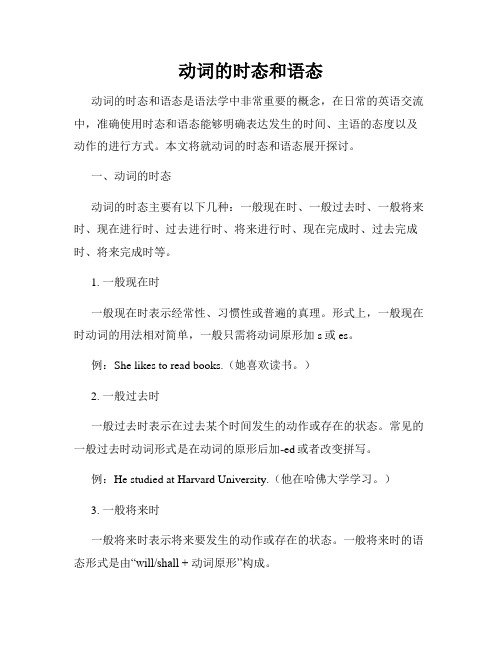
动词的时态和语态动词的时态和语态是语法学中非常重要的概念,在日常的英语交流中,准确使用时态和语态能够明确表达发生的时间、主语的态度以及动作的进行方式。
本文将就动词的时态和语态展开探讨。
一、动词的时态动词的时态主要有以下几种:一般现在时、一般过去时、一般将来时、现在进行时、过去进行时、将来进行时、现在完成时、过去完成时、将来完成时等。
1. 一般现在时一般现在时表示经常性、习惯性或普遍的真理。
形式上,一般现在时动词的用法相对简单,一般只需将动词原形加s或es。
例:She likes to read books.(她喜欢读书。
)2. 一般过去时一般过去时表示在过去某个时间发生的动作或存在的状态。
常见的一般过去时动词形式是在动词的原形后加-ed或者改变拼写。
例:He studied at Harvard University.(他在哈佛大学学习。
)3. 一般将来时一般将来时表示将来要发生的动作或存在的状态。
一般将来时的语态形式是由“will/shall + 动词原形”构成。
例:I will go to the park tomorrow.(明天我将去公园。
)4. 现在进行时现在进行时表示正在进行的动作。
现在进行时的时态形式是由“be 动词(am/is/are)+动词-ing形式”构成。
例:They are playing basketball now.(他们现在正在打篮球。
)5. 过去进行时过去进行时表示过去某个时间正在进行的动作。
过去进行时的时态形式是由“was/were + 动词-ing形式”构成。
例:He was studying at the library yesterday.(昨天他在图书馆学习。
)6. 将来进行时将来进行时表示将来某个时间正在进行的动作。
将来进行时的时态形式是由“will be + 动词-ing形式”构成。
例:They will be traveling to Europe next month.(他们下个月将要去欧洲旅行。
动词的时态和语态
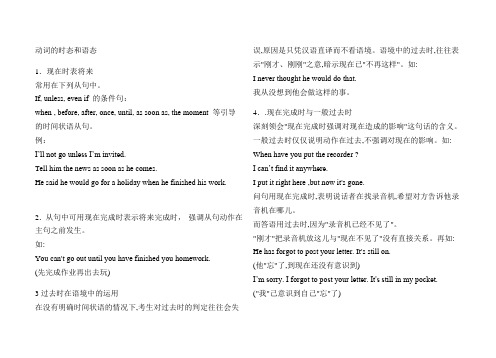
动词的时态和语态1.现在时表将来常用在下列从句中。
If, unless, even if 的条件句:when , before, after, once, until, as soon as, the moment 等引导的时间状语从句。
例:I’ll not go unless I’m invited.Tell him the news as soon as he comes.He said he would go for a holiday when he finished his work.2.从句中可用现在完成时表示将来完成时,强调从句动作在主句之前发生。
如:You can't go out until you have finished you homework.(先完成作业再出去玩)3过去时在语境中的运用在没有明确时间状语的情况下,考生对过去时的判定往往会失误,原因是只凭汉语直译而不看语境。
语境中的过去时,往往表示"刚才、刚刚"之意,暗示现在已"不再这样"。
如:I never thought he would do that.我从没想到他会做这样的事。
4..现在完成时与一般过去时深刻领会"现在完成时强调对现在造成的影响"这句话的含义。
一般过去时仅仅说明动作在过去,不强调对现在的影响。
如: When have you put the recorder ?I can’t find it anywhere.I put it right here ,but now it's gone.问句用现在完成时,表明说话者在找录音机,希望对方告诉他录音机在哪儿。
而答语用过去时,因为"录音机已经不见了"。
"刚才"把录音机放这儿与"现在不见了"没有直接关系。
再如: He has forgot to post your letter. It's still on.(他"忘"了,到现在还没有意识到)I’m sorry. I forgot to post your letter. It's still in my pocket. ("我"己意识到自己"忘"了)5.This / It is the first / second …time +that从句。
动词的时态和语态

【翻译句子】 (7) He told me he read an interesting novel last night. 他告诉我他昨晚看了一本有趣的小说。 【结论2】如果从句中有一个过去的时间状语,尽 管从句中的动作先于主句发生,但从句中的谓语动 词仍用过去式。 【结论3】表示两个紧接着发生的动作,常由以下 词语连接,用一般过去时。常见连词有:but, and, when, as soon as, immediately, the moment, the minute。 如 : He rushed into the room and sat down immediately.
【疑难2】 We had no sooner been seated than the bus started. = No sooner had we been seated than the bus started. 【疑难剖析2】hardly / scarcely…when (before);no sooner…than表示“一……就……”。
3. 一般将来时 【翻译句子】 (8)我们下周将会讨论这个话题。 We will talk about this topic next week. 【结论1】表示未来的动作或状态常用will / shall + 动词(常与表示将来的时间状语连用,如tomorrow, next week等)。
【翻译句子】 (9) The bus is coming. 公共汽车就要到了。 【结论2】表示一种趋向或习惯动作。表示趋向行 为的动词,如come,go,start,begin,leave等词, 常用进行时的形式表示将来时。
【疑难2】The room remains clean. You are allowed to speak here. 【疑难剖析2】下面四类动词不宜用现在进行时: a. 表示心理状态、情感的动词:like, love, hate, care, remember, believe, want, mind, wish, agree, mean, need。 b. 表存在的状态的动词:appear, exist, lie, remain, seem, belong to, depend on。 c. 表示瞬间动作的动词:allow, accept, permit, promise, admit, complete。 d. 表示感官的动词:see, hear, notice, feel, smell, sound, taste, look。
动词的时态和语态(简单)

动词的时态和语态一)一般现在时(表日常行为、习惯、客观情况或按计划安排好的行为等);常见的时间状语有:every day, every morning, often, usually, always, sometimes, once a week, every other day等。
一般现在时有一个要把握的重点是:第三人称单数作主语时,谓语动词要加s或es。
第三人称单数常指单个的人、人名、物体、动物或指示代词等。
如:he, she, it, the boy, a man, Liping, my brother, our English teacher, a dog, a city, the river等。
观察下列句子,并把它们改成否定句:1.Lilei has his breakfast at 6:00 every morning.2.My father watches TV every evening.3.My parents watch TV every evening.4.Jack goes to work at 7:30 on weekdays.5.Tim often plays football with his classmates in the afternoon.6.They often play football in the afternoon.7.There are 60 students in our class.8.Liming is very interested in physics.翻译下列句子:1.李东每天做运动,他的身体很强壮。
_________________________________________________ 2.李明喜欢玩电脑游戏。
_______________________________________________________________ 3.他们通常晚饭后去散步。
!!!复习八:动词时态和语态
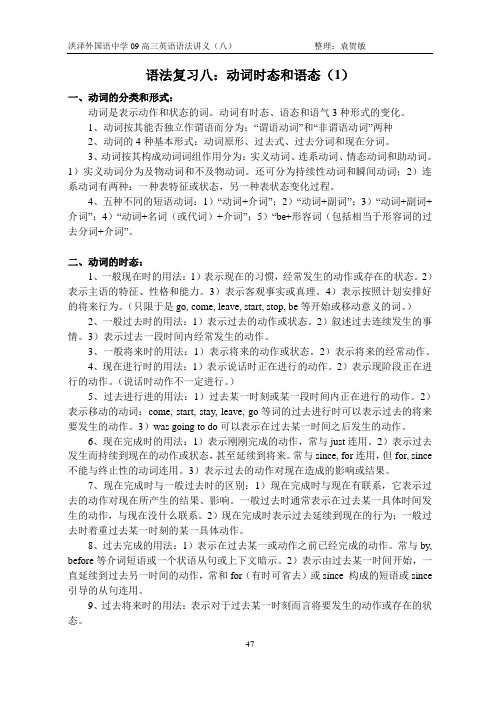
语法复习八:动词时态和语态(1)一、动词的分类和形式:动词是表示动作和状态的词。
动词有时态、语态和语气3种形式的变化。
1、动词按其能否独立作谓语而分为:“谓语动词”和“非谓语动词”两种2、动词的4种基本形式:动词原形、过去式、过去分词和现在分词。
3、动词按其构成动词词组作用分为:实义动词、连系动词、情态动词和助动词。
1)实义动词分为及物动词和不及物动词。
还可分为持续性动词和瞬间动词;2)连系动词有两种:一种表特征或状态,另一种表状态变化过程。
4、五种不同的短语动词:1)“动词+介词”;2)“动词+副词”;3)“动词+副词+介词”;4)“动词+名词(或代词)+介词”;5)“be+形容词(包括相当于形容词的过去分词+介词”。
二、动词的时态:1、一般现在时的用法:1)表示现在的习惯,经常发生的动作或存在的状态。
2)表示主语的特征、性格和能力。
3)表示客观事实或真理。
4)表示按照计划安排好的将来行为。
(只限于是go, come, leave, start, stop, be等开始或移动意义的词。
)2、一般过去时的用法:1)表示过去的动作或状态。
2)叙述过去连续发生的事情。
3)表示过去一段时间内经常发生的动作。
3、一般将来时的用法:1)表示将来的动作或状态。
2)表示将来的经常动作。
4、现在进行时的用法:1)表示说话时正在进行的动作。
2)表示现阶段正在进行的动作。
(说话时动作不一定进行。
)5、过去进行进的用法:1)过去某一时刻或某一段时间内正在进行的动作。
2)表示移动的动词:come, start, stay, leave, go等词的过去进行时可以表示过去的将来要发生的动作。
3)was going to do可以表示在过去某一时间之后发生的动作。
6、现在完成时的用法:1)表示刚刚完成的动作,常与just连用。
2)表示过去发生而持续到现在的动作或状态,甚至延续到将来。
常与since, for连用,但for, since 不能与终止性的动词连用。
动词时态语态

动词的时态和语态一、时态(1)表述客观真理和客观存在及自然现象;表示习惯性,经常性的动作,或经常存在的状态。
常见的时间状语有:often,usually,always,sometimes,now and then等。
The sun rises in the east and sets in the west.太阳从东方升起,从西边落下。
We have meals three times a day.我们一日三餐。
(现在的习惯)He is always ready to help others.他总是乐于助人。
(现在的状态)(2009·天津高考)My parents_________ in Hong Kong.They were born there and have never lived anywhere else.A.liveC.were livingD.will live(2)用于时间、条件、方式、让步状语从句中,表示将要发生的动作。
If you work hard,you will succeed next year.如果你努力,明年你就会成功。
What are you going to be when you grow up?你长大后干什么?(3)表示正在发生的动作或存在的状态。
There goes the bell.铃响了。
表示过去某一时间发生的动作或存在的状态。
常常给出过去的时间状语,如yesterday,last night,at that time等。
2009·全国卷Ⅰ)Edward,you play so well.But I__________ you played the piano.A.didn't knowB.hadn't knownC.don't knowD.haven't known(1)be going to+动词原形表示打算、计划、准备要做某事。
动词的时态和语态

动词的时态和语态时态和语态是语法中非常重要的概念,在句子中用来表达时间和动作主体的关系。
时态表示动作发生的时间,而语态则表示动作主体与动作之间的关系。
在英语中,时态和语态的正确运用对于准确表达意思至关重要。
一、动词的时态时态是指动作发生的时间,根据发生的时间可以划分为一般过去时、一般现在时、一般将来时等。
下面将分别介绍这几种时态的用法。
1. 一般过去时一般过去时表示过去某个时间发生的动作或存在的状态。
例如:- I went to the park yesterday.(我昨天去了公园。
)- She studied English for three hours last night.(她昨晚学了三个小时的英语。
)2. 一般现在时一般现在时表示现在经常发生的动作、全面性的真理、客观存在的事实等。
例如:- He usually plays basketball on weekends.(他通常在周末打篮球。
)- Water boils at 100 degrees Celsius.(水在100摄氏度时煮沸。
)3. 一般将来时一般将来时表示将来某个时间要发生的动作或存在的状态。
例如:- I will visit my grandparents next month.(我下个月会去看望我的祖父母。
)- They are going to have a party tomorrow.(他们明天要开派对。
)二、动词的语态语态是指动作主体与动作之间的关系,根据动作主体的不同可以分为主动语态和被动语态。
1. 主动语态主动语态表示主语是动作的执行者。
例如:- She wrote an article for the newspaper.(她为报纸写了一篇文章。
)- They are building a new house.(他们正在建一所新房子。
)2. 被动语态被动语态表示主语是动作的承受者。
例如:- The book was written by Mark Twain.(这本书是马克·吐温写的。
动词的时态和语态讲解

一、动词的时态和语态(一)动词的时态。
英语动词有16种时态,但是常用的只有9种:一般现在时、一般过去时、一般将来时、现在进行时、过去进行时、现在完成时、过去完成时、过去将来时、现在完成进行时。
下面分别介绍。
1、一般现在时的用法。
1)表示经常性、习惯性的动作;表示现在的状态、特征和真理。
句中常用often, usually, every day 等时间状语。
例如:a. He goes to school every day.b. He is very happy.c.The earth moves around the sun.2) 在时间状语从句和条件状语从句中,用一般现在时表示将来。
例如:a. If you come this afternoon, we’ll have a meeting.b. When I graduate, I’ll go to countryside.3) 有时这个时态表示按计划、规定要发生的动作(句中都带有时间状语),但限于少数动词,如:begin, come, leave, go ,arrive, start , stop, return, open, close 等。
例如:a. The meeting begins at seven.b. The rain starts at nine in the morning.4) 表示状态和感觉的动词(be, like, hate, think, remember, find, sound 等)常用一般现在时。
a. I like English very much.b. The story sounds very interesting.5) 书报的标题、小说等情节介绍常用一般现在时。
2.一般过去时的用法。
1)表示过去某时间发生的事、存在的状态或过反复发生的动作。
a. He saw Mr. Wang yesterday.b. He worked in a factory in 1986.2)表示过去经常发生的动作,也可用“used to “ 和“would + 动词原形”。
动词的时态和语态
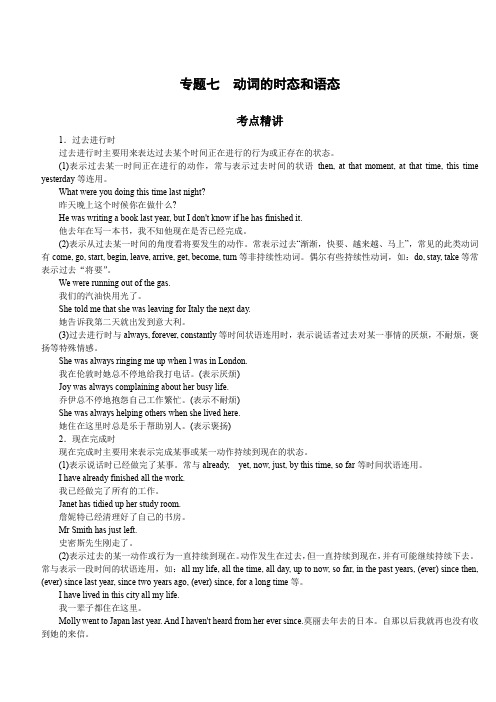
专题七动词的时态和语态考点精讲1.过去进行时过去进行时主要用来表达过去某个时间正在进行的行为或正存在的状态。
(1)表示过去某一时间正在进行的动作,常与表示过去时间的状语then, at that moment, at that time, this time yesterday等连用。
What were you doing this time last night?昨天晚上这个时候你在做什么?He was writing a book last year, but I don't know if he has finished it.他去年在写一本书,我不知他现在是否已经完成。
(2)表示从过去某一时间的角度看将要发生的动作。
常表示过去“渐渐,快要、越来越、马上”,常见的此类动词有come, go, start, begin, leave, arrive, get, become, turn等非持续性动词。
偶尔有些持续性动词,如:do, stay, take等常表示过去“将要”。
We were running out of the gas.我们的汽油快用光了。
She told me that she was leaving for Italy the next day.她告诉我第二天就出发到意大利。
(3)过去进行时与always, forever, constantly等时间状语连用时,表示说话者过去对某一事情的厌烦,不耐烦,褒扬等特殊情感。
She was always ringing me up when l was in London.我在伦敦时她总不停地给我打电话。
(表示厌烦)Joy was always complaining about her busy life.乔伊总不停地抱怨自己工作繁忙。
(表示不耐烦)She was always helping others when she lived here.她住在这里时总是乐于帮助别人。
动词的时态和语态

第九讲动词的时态和语态Ⅰ动词的时态英语中不同时间和方式发生的动作或状态时要用谓语动词的不同形式来表示,这种表示动作或状态发生时间和方式的形式称作动词时态。
一一般现在时一般现在时主要用来表示每天、每周等经常一直如此,长期进行下去的动作,其着眼点不在描述具体的动作,而是通过提出不断反复的动作,来说明某一真理或某一经常性习惯性的举动。
一般现在时的几种主要用法。
1)一般现在时表示客观事实、客观存在的普遍真理、用于一般现在时的时间状语常见的有:often,usually,always,sometimes,seldom,ever,never,everyday(week,month,year,) once a year,now and then,from time to time.Eg:The earth moves around the sun.Shanghai lies in the east of China.2)表示格言或警句。
Eg:Pride goes before a fall.(骄者必败)注意:此用法如果出现在宾语从句中,即使主语是过去时,从句谓语也要用一般现在时。
Eg:Columbus proved that the earth is round.3)表示现在习惯的、经常重复的或定期发生的动作或存在的状态。
Eg:I leave home for school at 7 every morning.We go to school every day except on Sunday.4)表示能力、性格、个性等。
Eg:I do not know so much.Ann writes good English but does not speak English well.注意:1)表示“感觉”“状态”或“关系”的动(如:be ,like,love,hate,want,think,remember,find,sound,forget, Refuse,see,allow,prove,have,matter,taste,look,feel)常用一般现在时,不用现在进行时。
动词的时态和语态

6.现在完成时:have/has been+过去分词 The classroom has been cleaned . 7.过去完成时:had been+过去分词 When we got there, the classroom had been cleaned . 8.含情态动词的被动语态:表示某动作可能、 应该、必须被做(情态动词+be+过去分词) The classroom must be cleaned every day
8.现在完成进行时: 助动词have/has+ been+v-ing We have been learning English for four years.
*表示状态用be+表语(常用名词或形容词)。
1.现在的状态:am, is, are+表语: I am a student. He is my classmate. 2.过去的状态:was, were+表语: I was 16 last year. They were my classmates. 3.将来的状态:will be+表语: He will be a teacher next year.
3.一般将来时: (1) 助动词will/shall+动词原形: (2)be going to+动词原形: He will play basketball tomorrow. He is going to play basketball tomorrow.
4.现在进行时:助动词am/is/are+v-ing He is playing basketball now.
5.过去进行时:助动词was/were+v-ing He was playing basketball at ten yesterday.
动词的时态和语态(一)

3. 一般将来时
1 .一般将来时表示计划、打算、企图做某事或来注 定要发生的事情。
2 .表示将来时的四种形式 ①will /shall +动词原形 ②be going to do ③be about to do(正要干什么) ④be to do
① be going to 有很强的计划性,打算干什么,而will 表示谈话时临时决定的意图,具有临时性和偶然 性。 ----The telephone is ringing. ----I _____ answer it. A. will B. am going to C. am to D. am about to ---Alice, why didn’t you come yesterday? ---I _____, but I had an unexpected visitor. A. had B. would C. was going to D. did ②be going to 可用来表达某种迹象要发生的事。而 will 不能表示 Look at the clouds! It ’s going to rain.
一般过去时通常表示过去一段时间的习惯性动作或状 态或过去某一具体时间发生的动作或所处的状态。 注意:过去时有时并不实际表示过去的动作或状态。受 主句过去时态影响,从句用过去时态;表示虚拟语气时 用过去时态。 常见的时间状语有: yesterday, (two days/…) ago , last
(year/…),the other day(前几天),once upon a time(很久 before liberation(解放前……),When I was 8 years old(当
1 一般现在时的用法
2) 客观真理,客观存在,科学事实或表示格言或 警句。 ①Knowledge begins with practice. ② She said that the sea water is salty. ③In some parts of the world, such as in England , tea ____ with milk and sugar. A. is serving B. serves C. is served D. served
重点归纳:动词的时态和语态
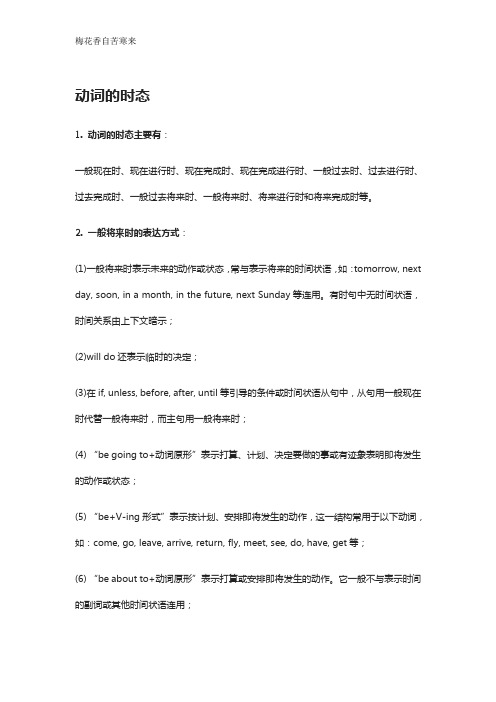
动词的时态1. 动词的时态主要有:一般现在时、现在进行时、现在完成时、现在完成进行时、一般过去时、过去进行时、过去完成时、一般过去将来时、一般将来时、将来进行时和将来完成时等。
2. 一般将来时的表达方式:(1)一般将来时表示未来的动作或状态,常与表示将来的时间状语,如:tomorrow, next day, soon, in a month, in the future, next Sunday等连用。
有时句中无时间状语,时间关系由上下文暗示;(2)will do还表示临时的决定;(3)在if, unless, before, after, until等引导的条件或时间状语从句中,从句用一般现在时代替一般将来时,而主句用一般将来时;(4) “be going to+动词原形”表示打算、计划、决定要做的事或有迹象表明即将发生的动作或状态;(5) “be+V-ing形式”表示按计划、安排即将发生的动作,这一结构常用于以下动词,如:come, go, leave, arrive, return, fly, meet, see, do, have, get等;(6) “be about to+动词原形”表示打算或安排即将发生的动作。
它一般不与表示时间的副词或其他时间状语连用;(7) “be to+动词原形”表示按计划、安排即将发生的动作;(8) 一般现在时表示按时刻表或根据规定将要发生的动作,这一结构常用于表示位移的动词,如:come, go, leave, start, begin, take off, set off等。
动词的语态1. 一般现在时的被动语态:is/am/are+V-ed。
例如:English is widely spoken all over the world.2. 一般过去时的被动语态:was/were+V-ed。
例如:The underground was built five years ago.3. 一般将来时的被动语态:①will/shall be+V-ed。
专题八 动词的时态、语态

③表单纯性的将来,与人的主观愿望和判断无关 时。 If it's made of wood, it will float on water. 这要是木材做的,它能浮在水面上。 (4)当主句为一般将来时态时,在 if, as soon as, until, when等引导的状语从句中用一般现在时代替一 般将来时。 I will call you as soon as I get there. 我一到那儿就给你打电话。
②表示过去经常或反复发生的动作,常与 always , usually, often, 度的时间状语连用。 When I was a child, I often played football in the street. 当我是个孩子的时候,我经常在街上踢足球。 注:表示过去经常发生或反复发生的动作,也可 用 used to或 would+动词原形。 I used to go to the library every Sunday. 我以前每个周日都去图书馆。 never,sometimes等表示频
(5)动词的现在进行时表将来。 常见的动词有 go, come, leave, stay, start等。 Joe is leaving for London. 乔就要动身去伦敦。
(6)be about to do 结构表示客观、马上就要发生 的事,一般不与具体的时间状语连用。 be to do结构表示按职责、义务和要求必须去做 或即将发生的动作。 The plane is about to take off. 飞机就要起飞了。 Jenny is to be married next month. 珍妮下个月 结婚。
When shall we finish homework? 我们应该什么时候完成作业? I shall make a cake for your birthday tomorrow. 明天我将为你的生日制作一个蛋糕。
(完整版)动词的时态和语态变化规则

(完整版)动词的时态和语态变化规则一、动词的时态变化规则动词的时态指的是动作发生的时间。
汉语中的动词时态有三种形式:过去时、现在时和将来时。
下面是动词在不同时态下的变化规则:1. 过去时动词的过去时表示动作或状态发生在过去的时间。
在汉语中,动词的过去时通常通过在动词前加上过去时标志词(如“了”、“过”、“了解”等)来表示。
例如:- 我昨天去了图书馆。
- 她去年去过美国。
2. 现在时动词的现在时表示动作或状态发生在现在的时间。
在汉语中,动词的现在时可以通过以下几种方式来表示:- 在动词前面加上表示现在的时间状语(如“现在”、“正在”、“每天”等)- 在动词前面加上表示频率的词语(如“经常”、“常常”、“总是”等)例如:- 我现在在写作业。
- 他经常打篮球。
3. 将来时动词的将来时表示动作或状态将要发生的时间。
在汉语中,动词的将来时可以通过以下几种方式来表示:- 在动词前面加上表示将来的时间状语(如“明天”、“以后”、“将来”等)- 在动词前面加上表示计划或意向的词语(如“打算”、“计划”、“想要”等)例如:- 我明天要去游乐园。
- 她打算明年去留学。
二、动词的语态变化规则动词的语态表示动作的主体与动作的关系。
汉语中的动词语态有两种形式:主动语态和被动语态。
1. 主动语态在主动语态中,动作的执行者是动词的主语。
这种语态表达的是动作的主体主动地执行了动作。
例如:- 她写了一首诗。
- 我们清理了房间。
2. 被动语态在被动语态中,动作的执行者是动词的宾语。
这种语态强调的是动作的接受者。
被动语态的构成是:动词“是/被” + 动词的过去分词。
例如:- 这篇文章被他认为很好。
- 这个问题被我们解决了。
以上是动词的时态和语态变化的基本规则,希望对您有所帮助。
动词的时态和语态
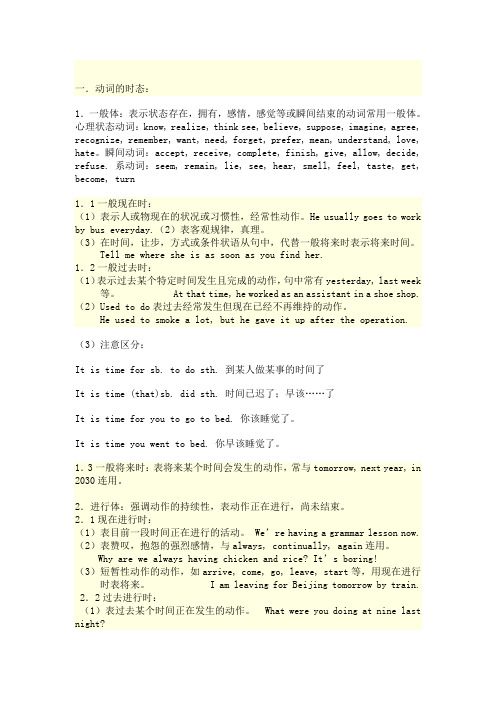
一.动词的时态:1.一般体:表示状态存在,拥有,感情,感觉等或瞬间结束的动词常用一般体。
心理状态动词:know, realize, think see, believe, suppose, imagine, agree, recognize, remember, want, need, forget, prefer, mean, understand, love, hate。
瞬间动词:accept, receive, complete, finish, give, allow, decide, refuse. 系动词:seem, remain, lie, see, hear, smell, feel, taste, get, become, turn1.1一般现在时:(1)表示人或物现在的状况或习惯性,经常性动作。
He usually goes to work by bus everyday.(2)表客观规律,真理。
(3)在时间,让步,方式或条件状语从句中,代替一般将来时表示将来时间。
Tell me where she is as soon as you find her.1.2一般过去时:(1)表示过去某个特定时间发生且完成的动作,句中常有yesterday, last week 等。
At that time, he worked as an assistant in a shoe shop. (2)Used to do表过去经常发生但现在已经不再维持的动作。
He used to smoke a lot, but he gave it up after the operation.(3)注意区分:It is time for sb. to do sth. 到某人做某事的时间了It is time (that)sb. did sth. 时间已迟了;早该……了It is time for you to go to bed. 你该睡觉了。
- 1、下载文档前请自行甄别文档内容的完整性,平台不提供额外的编辑、内容补充、找答案等附加服务。
- 2、"仅部分预览"的文档,不可在线预览部分如存在完整性等问题,可反馈申请退款(可完整预览的文档不适用该条件!)。
- 3、如文档侵犯您的权益,请联系客服反馈,我们会尽快为您处理(人工客服工作时间:9:00-18:30)。
动词的时态一.一般现在时:定义:①表示经常或习惯性动作。
②表示客观真理,科学事实或名言警句。
结构:①be:am/is/are②实意动词:原形或者单三(do/does/don't/doesn't)标志词:①频率副词:always,sometimes, usually ,often...②时间状语:on Monday,in the morning,every day,every week...③表频率的词组:once a week,three times a year...二.一般过去时定义:①表示过去某个时间或某一段时间发生的动作或存在的状态。
②表示过去经常反复发生的动作常与often,always等频度副词连用。
结构:①be:was/were②实意动词:过去式(did/didn't)标志词:...ago,last...,yesterday...,the day before yesterday,in 1990,just now,one morning,that winter,once upon a time,at the age of...典型例题:1.The teacher told us the earth __ around the sun.A. goB.goesC. went2 .I don't know when she ___tomorrow.You ___ me as soon as she arrives.A. arrives / callB. will arrive/ will callC.will arrive/ call3. Here __ the bus.A. comesB.is comingC. came4.Lucy __ the room and put away her things.A. enter B entered C.is entering5. The teacher is already standing here. Do you know when she __ ?esB.is comingC. came6. Sorry , I __ the sign“NO PARKING!”here. I'll drive away soon.A.won't seeB. don't seeC. didn't see三.现在进行时定义:表示现在或现阶段正在进行的动作存在的状态.结构: is/am/are + doing标志词:Look! Listen! now, It's+点钟,these days,上下文提示四.过去进行时定义:表示过去某个时刻或某一段时间正在进行的动作。
结构:was/were + doing标志词:at this /that time yesterday,at eight last night,when/while引导的时间状语从句典型例题:1.(2016齐市)I was writing a letter ___ she was making a telephone call.2.A.while B.when C. before3.2. (2019怀化)4.Tom ___ computer games when his father got home.5.A. was playing B.plays C.played6.3. Alice __ always __ her mind.7.A. is / changing B.×/ changes8.C.×/ changed9.五.一般将来时10.定义:表示将要发生的动作或存在的状态。
11.结构:12.①will/shall + do13.②be going to + do(计划,打算,某种迹象表明要发生的事)14.标志词: tomorrow,the day after tomorrow,next week,soon,in 10 minutes,in 205015.六.过去将来时16.定义:表示过去某一时间将要发生的动作或存在的状态。
17.结构:18.①would + do19.②was/were going to + do20.标志词:上下文提示典型例题:1.(2018河南)-- Honey,where are you?-- I ___. Just let me put on my shoes.eB.am comingC.have come2.(2015重庆)Stop smoking,Joe! You___ yourself if you keep on doing it like that.A.killB.will killC. have killed3.--Don't be late again.--Sorry, ___.A. I don't.B. I won't.C. I am not.4.There ___ a football match next week.A.is going to beB.will haveC.is going to have5.He said that he ___ for me at the gate.6.A.will wait B. would wait C. waits7.七.现在完成时8.定义:表示过去发生的动作对现在造成的影响或结果.9.结构: have/has + done10.标志词: already,yet,ever,never,just,11.before,since,for,so far,by far,up till now,up to now,in the past ten years...12.八.过去完成时13.定义:表示过去某一时间或动作之前已经发生或完成的动作或状态即“过去的过去”。
14.结构: had + done15.标志词: 常与by/before+ 过去的时间构成的短语;by thetime/when...引导的时间状语从句16.1.常见短暂性动词与延续性动词替换17.become - ___ borrow/lend - ___18.buy - ___ begin - ___19.die - ___ leave - ___20.open - ___ close - ___21.marry - ___ come/arrive - ___22.fall asleep - ___ fall ill - ___23.join - _______/_________24.2. 主句(______时) + since + 从句(_____时).25.3.have been to: _____have gone to:______have been in:______典型例题:1.(2019武汉)2.I ate some fruit, which I ___ since I was a child, and the vegetables from my garden.3.A.enjoyed B.have enjoyed C.enjoy4.2.(2019呼和浩特)5.The shop in WANDA PLAZA___ for six years, but I___ there so far.6.A.has opened;haven't gone7.B.has been open;haven't been8.C. has been opened; haven't been9.3. The meeting ____ for ten minutes when I got there.A.has begunB.had been onC.had begun4.(2017重庆)Many schools___ the ways of doing morning exercises in the past few years.A.changeB.changedC. have changed现在完成进行时定义:表示某个动作从过去某个时间开始,一直延续到现在,并且还有可能持续下去。
构成:have/has been + 现在分词例句:The children have been having a lot of fun.动词的语态一.被动语态的构成:主语(承受者)+ be + done(及物动词的过去分词)+ (by+ 发出者)二.常见时态的主动语态和被动语态构成:三.注意事项:1.主动语态省略to,被动语态出现to.(see,hear,watch,feel,notice,make,have...)2.动词短语变为被动语态,构成短语的介词或副词不可省。
3.无被动语态1)不及物动词及词组(happen,take place,break out)2)表所属关系的动词及词组(have,belong)3)系动词无被动(sound,taste,look,smell,feel...)4)主动语态的宾语是each other或反身代词时4.主动表被动1)不及物动词+表程度方式的状语时(sell well,write smoothly...)2)need/want/require+doing = need/want/require+ to be done3)be worth doing 值得做...4)cost , fit...典型例题:1.We should take good care of the weak.(变为被动语态)2.A car accident___ (happen) last night.3.①The dictionary___ (sell) well.②Three sheep___ (sell) to a rich manyesterday.4.The flowers need___(water) every day.5.He was seen___(enter) the room just now.。
